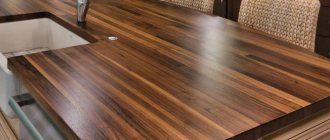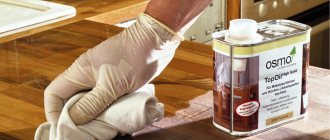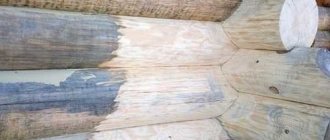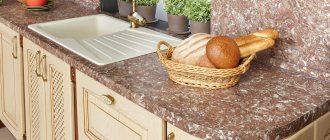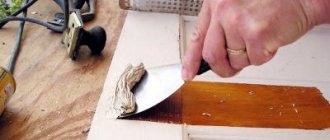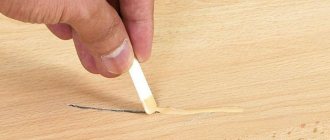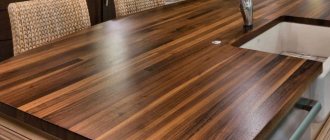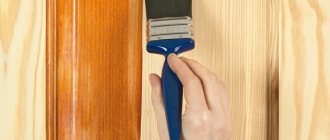Any wooden products need protection from environmental influences. Especially those that are stored in the kitchen - during cooking, the air humidity and temperature rise there. Water particles get into the wood fibers, which will lead to cracks on the surface in the future. Excess moisture can cause accelerated development of bacterial colonies on the tree. Oil coating will solve this problem. Craftsmen with many years of experience know how to choose oil for wooden countertops and provide the best protection against mechanical and other damage. For this purpose, various mineral and plant mixtures are used. It is important to consider all compositions - both traditional, proven, and more modern varnishes and impregnations.
Types of oils by drying
What oil should I use to coat my countertop? Oil impregnations intended for the care of countertops made of wood are available in drying and non-drying types. This fact depends on the raw materials included. In the first case, the mixture with the addition of tung oil hardens when interacting with wood. Due to oxidation and polymerization of fibers, surfaces treated with such material are not washed off with water. Non-drying compositions contain natural oils (thistle, sunflower, soybean) and wax, which form a thin water-repellent layer to protect the countertop.
Osmo HANDXCENTER machine
Manual electric disk machine HANDXCENTER OSMO New 2021! 2 in 1 tool. Paint the primary paint, renew the existing coating, care for the surface. Eccentric movement, large pad diameter. Osmo wood paint is now in good hands.
Surface preparation
Before processing, the wooden covering is cleaned of accumulated dirt and grease. After using detergents and degreasers, it is washed with clean water and then dried. If paint and varnish treatment of wood was previously used, then it should be removed using a special liquid that removes old paint. A thick layer of dirt is sanded with coarse sandpaper. After cleaning, carefully remove the settled dust using a vacuum cleaner.
What are the popular models?
Product classification is carried out according to basic technical parameters: viscosity, density, type of volatile compounds, amount of dry residue, and the presence of special additives. The following types of oils are considered widespread and in demand:
| Types of coating | Description |
| Degtyarnoe | The main difference from other products is the strongest antiseptic abilities. Refers to natural ingredients. The composition contains turpentine, wood resins and linseed oil. Area of application: processing of piers, yachts, boats and other watercraft. Ideal for impregnating log buildings, gazebos and garden furniture. There is no need for thinner. |
| Tung | It is extremely popular among those who need to protect wooden structures from excessive humidity. Suitable for interior work. Prevents the appearance of rot, mold, mildew, and insects. The scope of application is varied. It opens dishes and furniture, walls and ceilings. The penetration time into the upper layers of logs is minimal. Helps improve structure. To prevent thickening and increased consumption, experts recommend manipulating it at temperatures above 15 degrees Celsius. |
| Linen | The best natural product. Inexpensive and high quality. It has excellent protective characteristics and waterproofing properties. Can be used for interior and exterior work. Popular models are widely used for impregnation of facades, exterior and interior items, and furniture. Penetrates into any hard-to-reach areas, including microcracks. The result is a durable, waterproof film. |
| Vaseline | Belongs to the organic category. The main components are saturated paraffinic carbon compounds. A good choice for covering any wooden products. It is very popular due to its lack of color and odor. Emphasizes the natural beauty of structures. Upon completion of drying, a thin film is formed on the surface, characterized by moisture-repellent qualities. The result is the impossibility of deformation and cracking. |
| Sunflower | Applicable in exceptional cases. The amount of polyunsaturated components is at a minimum level, which does not allow you to fully obtain a decent enveloping effect. Over time, the wood may begin to rot and damaged areas will appear. There is also no polymerization, which prevents it from drying completely. |
| Teak | It is considered a universal and environmentally friendly product. The main components are purified turpentine, linseed oil and tung oil. Used for external and internal work. Often purchased for impregnation of valuable wood species. Breeding is strictly prohibited. You can purchase it at specialized retail outlets or order it online in an online store. |
| Danish | It has nothing to do with Denmark. Special development. A variety of natural resins and components of plant origin are used in production. Allows you to create natural beauty matte finishes. Suitable for use inside and outside. Can be used either independently or as an additional impregnation. Ideally emphasizes the natural beauty of the timber. No shine appears on the surface. |
| Toning | In addition to its protective functions, it helps create a beautiful shade on the surface. Can be used on almost all types of wood. The composition contains natural pigments. The basis is oxidized vegetable fats. Able to prevent damage to the material from fungus and mold, dust and pollution, rotting and getting wet, harmful insects, drying out and fading, and the appearance of microcracks. Can be used for impregnation of: • floors; • stairs; • furniture; • beams; • linings; • external finishing of buildings; • parquets. |
| Mineral | Used in industry for impregnation of deeply cleaned surfaces. It is practically not used in everyday life, except sometimes for outdoor work. To treat external decorative products and facades of non-residential buildings, a mixture of vegetable and mineral oils is used. |
| Colored and white | Area of application: treatment of structures damaged by mold or insects. The white substance is used for tinting if there is a need to lighten surfaces. On store shelves you can find products from domestic and foreign manufacturers. The main purpose is to paint furniture, decorative elements, and walls. Completely safe. The composition contains no toxic elements. Colored models give the logs the desired shade. They can be used to paint lining, sawn boards, planed logs. |
Application
Hard wax oil for kitchen countertops should not be diluted with anything before use. It is applied immediately after mixing. The first thin layer is applied with a roller, brush or any lint-free cloth. With sufficient room ventilation, the product dries within 10 hours. The next layer is applied in the same way. If the work was done with a brush, two coats will be enough. When using a cloth or soft sponge, apply 3-4 applications.
Wood oil base
Wood oils can be based on organic solvents or water.
- Oils based on organic solvents penetrate the wood structure much better, providing longer-lasting protection. However, the solvents themselves are very toxic, volatile and flammable, so their use is currently limited, although they are more effective.
- Water-based oils do not penetrate wood well, so they are used to lubricate the hardest types of wood and elements that will not be subjected to too intense use. The advantage of water-based oils is that they are (relatively) non-toxic and that they do not leave a distinctive odor.
Drying and caring for the countertop
After the oil has dried, to acquire shine, the wooden countertop is sprayed with a polish that is harmless to the kitchen. Then it is rubbed with a rag or cloth. Surface drying time ranges from 7 to 10 days. The speed is influenced by the temperature conditions in the room, which should not exceed + 20 degrees, with air humidity not lower than 55%. Subsequent care of the coating includes wet cleaning. To do this, the countertop, pre-treated with Osma oil, is cleaned with a product for the care and cleaning of wood products. After washing, wipe it with a dry cloth. Under the influence of external influences: moisture, mechanical stress, exposure to sunlight, wooden products are damaged again after a certain time. Manufacturers recommend treating countertops with oil every six months.
How to impregnate
Since you can oil a wooden countertop or kitchen board yourself, you don’t need the help of a professional. It is enough to follow simple rules:
- Prepare the surfaces by first sanding them with coarse, then medium, then fine-grain sandpaper.
- Remove dust with a dry brush; wet wiping should not be used.
- Apply the oil in several layers - 2-5, using intermediate drying. Each layer is kept until completely absorbed - at least 10 hours. You can impregnate the board using a brush, roller, gauze pad - depending on the size of the surface.
- Take dry gauze with your hand, fold it in several layers, remove excess mixture from the board.
You can buy ready-made impregnation in Minsk stores or order it for delivery, but if necessary, prepare it yourself. To create the mixture you need to prepare:
- Vaseline oil;
- beeswax;
- metal mixing container.
Four parts of oil are mixed with one part of wax, which is first cut into approximately equal pieces. The metal container is heated in a water bath, constantly stirring the composition. After a homogeneous mass is obtained, the impregnation is cooled. If necessary, it can be stored in the refrigerator or cellar.
Advice . It is not permissible to use stearin or paraffin for impregnation; these substances will clog the wood pores, which will lead to rotting of the board.
WAX
Like oil, wax is a natural, environmentally friendly material. But in addition to the water-repellent coating, it also creates protection against scratches and abrasions. Able to withstand common kitchen cleaning products.
Attention! Wax thins out quite quickly, so you will have to polish and renew the coating more often than with oil. Before each update, the old layer will have to be cleared.
Applying wax to part of the bar counter.
Applying wax to part of the bar counter.
Oil or varnish
Oils are often presented as an alternative to varnishes, but in reality they are not completely interchangeable. Varnishes primarily protect the surface and penetrate relatively poorly into the wood structure, creating a strong, durable layer on the surface, while oils penetrate deeper, but if the wood is worn away, the protection disappears.
In general, varnish works better on surfaces that experience a lot of wear or on softwood items, while oils are used on hardwoods.
This rule always applies - oils for exotic wood are no different from oils for local species, because the structure of the wood itself is exactly the same.
Wood oil color
- The basic option is to use colorless oils. They usually increase the contrast of the wood grain a little or make it a few shades darker, but usually the color doesn't change. Clear wood oil is used primarily for repairs, but also to protect and enhance the natural beauty of wood.
- Wood oil with paint has the same protective properties as the colorless version, but it contains pigments, thanks to which the wood can be tinted. The peculiarity of these colors is that colored varnishes are always chosen that are darker than the original color.
- Wood lightening oil complements the aesthetic possibilities. It is used relatively rarely and, above all, in repair work to restore the original appearance of wood. Lightening is an effect achieved thanks to aggressive compounds, so in their case you need to be especially careful and take care of the surrounding space when applying a protective layer.

